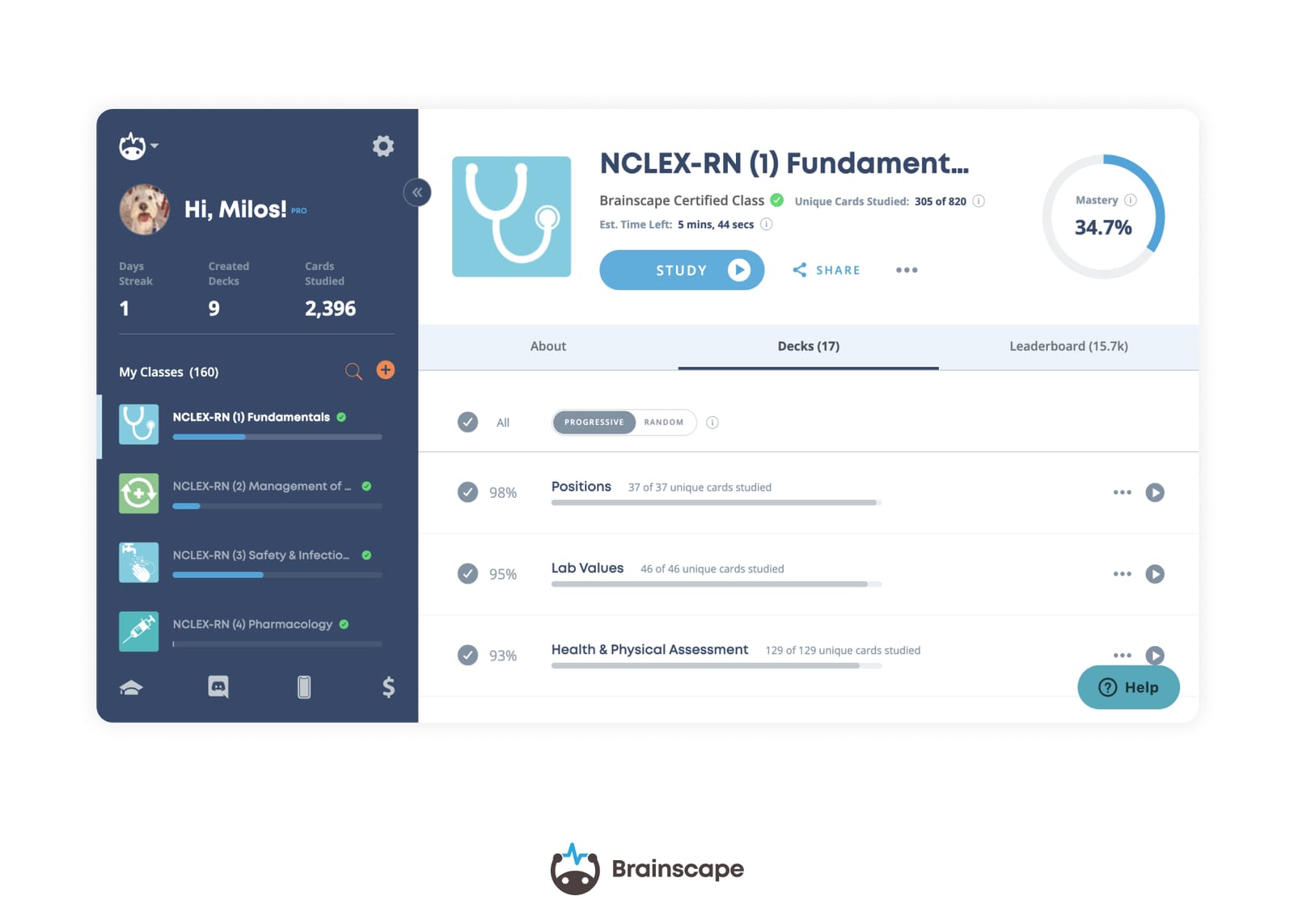Learning your NCLEX medications is vital for passing the exam and for practicing safe nursing. It's also the hardest, driest, and most overwhelming part of preparing for your licensing exam! And it’s easy to see why.
There’s a seemingly endless list of NCLEX meds, side effects, technical terms, and nursing considerations for Every. Single. One. of our modern medications. The good news is that you don't have to remember it all: there are certain facts you have to know and others you can bypass, and in this guide, we'll let you know which is which.
What to learn for each NCLEX medication
If you tried to learn every single thing about all the NCLEX meds covered in nursing school, you’d still be studying five years later. Fortunately, you don’t need to do this. Here’s what you need to know about each medication:
- Medication classifications
- Medication prefixes and suffixes
- Generic names
- The indication
- How the medication works (and which bodily system it influences)
- Side effects (the most common and the serious, adverse reactions)
- Nursing considerations
If this still seems like a long list, that’s okay. The truth is that all of these factors relate to each other, so learning one will help you to learn the others and we'll be guiding you through that in the coming sections.
(Psst! On the subject of making NCLEX meds easier, check out our list of top apps for nurses and nursing students! Also, make sure you get our free NCLEX study planners and exam countdown sheets to plot your path toward and remain razor-focused on your study goals!)
#1. How to study for the NCLEX: Learning your medication classifications
Here’s a list of the NCLEX medication classifications you’ll need to learn:
- Amphetamines
- Anti Allergy drugs
- Anti Alzheimer’s
- Antibiotics
- Anticonvulsants
- Antidepressants
- Antidiarrheals
- Antiemetics
- Antigout
- Antilipidemics
- Antineoplastics
- Antiosteoporotic
- Antiparkinsonians
- Antipsychotics
- Antispasmodics
- Anxiolytics
- Bronchodilators
- Corticosteroids
- Diuretics
- Erectile dysfunction drugs
- H2 receptor blockers
- Insulins
- Laxatives
- Muscle relaxers
- NSAIDs
- Opioids
- Proton pump inhibitors
- Stool softeners
- Thrombolytics
Again, this may seem like a long list! (Welcome to the NCLEX). But if you spread these over several weeks or months, it’s very manageable. The most digestible way to understand and memorize all of this information is with Brainscape's NCLEX Pharmacology flashcards. (Also available for the NCLEX PN exam.)

Brainscape has broken down this bible-length list of medications and related information into the most essential facts you need to know to crush the NCLEX. This saves you hours making these flashcards yourself and having to decide what's important and what's not (we've already done that for you). Then, our spaced repetition learning algorithm delivers each fact to you at the perfect time interval to optimize your learning and retention.
Also, these NCLEX meds flashcards cover the most important pharmacology concepts in the latest NGN test plan, as well as Saunders, Kaplan, Hurst, Lippincott, HESI, Khan Academy, and other top NCLEX review books and courses. In other words, no matter which one you’re using, we’ve got you covered!
Our digital flashcards really are the most efficient way to study for the NCLEX.

#2. How to study NCLEX meds: Learning medication prefixes & suffixes
As a nurse, it’s important to know your LOLs (beta-blockers) from your NITRO (antianginal). Learning the prefixes and suffixes for each classification of medication helps in two ways:
Firstly, it reduces what you need to learn because all you have to memorize is the prefix or the suffix of the NCLEX medication, and not the whole name.
For example, beta-blockers all end in the suffix -lol. So now you know that when you come across medications like Atenolol, Carvedilol, Metoprolol, or Nebivolol, it's a beta-blocker. In other words, instead of learning those FOUR medication names (and more), all you need to remember is that “-lol means “beta-blockers.”
Secondly, learning the prefixes and suffixes of your list of NCLEX meds gives you another hook to hang your knowledge on.
For example, if a patient comes to you with unpleasant side effects from Nebivolol, you will know immediately from the suffix that they're taking a beta-blocker. So, even if you’ve forgotten the exact particulars of the drug, your general knowledge of beta blockers will help you understand why the patient may be having side effects.
#3. How to study for the NCLEX: Learning the generic names of medications
For every drug, there’s a generic name, which refers to its chemical makeup. And then there’s the specific brand name developed and trademarked by a pharmaceutical company.
For example, the generic name for a strong opioid analgesic is Fentanyl. Some of the brand names for this drug are: Sublimaze, Actiq, Duragesic, Fentora, Abstral, Lazanda, and (many) others.
You’ll ONLY need to learn the generic names of the NCLEX medications and not all the brand names.
#4. How to study NCLEX meds: Learning the indication(s)
The indication is what the drug is used for. For example, ACE inhibitors are used to decrease blood pressure and heart rate to prevent myocardial infarction.
Understanding what the different NCLEX medications are used for (and how to safely use them) is a baseline requirement of your nursing education. Nurses must safely administer medications, answer patient questions, and identify side effects and adverse reactions. This requires nurses to have a thorough working knowledge of the most common medications prescribed.
#5. How to study for the NCLEX: Learning how medications work (the "mechanism of action")
The mechanism of action is how the medication works in the body at the cellular level. Knowing this will help you connect the drug to its indication and side effects.
For example, you know that ACE inhibitors treat hypertension: that’s the indication. The way they do this, (the mechanism of action) is by preventing the conversion of angiotensin I to angiotensin II. Angiotensin II is a potent vasoconstrictor. In other words, ACE inhibitors help to enlarge blood vessels, which, therefore, decreases blood pressure.
Understanding how the facts fit together is a powerful way to incorporate new knowledge into your memory inventory. When you connect cause and effect in a strong framework, you’re adding extra ‘hooks’ your brain can use to retrieve information during any exam or even on the job.
Therefore, knowing the mechanism of action for each NCLEX medication is important, both to give you a good knowledge base for prescribing meds and to help you memorize all the most important uses and side effects.
#6. How to study NCLEX medications: Remembering the side effects & adverse reactions for each med
Have you ever read the back of a pill bottle? Drug companies these days list every possible side effect that can arise (and several that have been noted in only a few patients). Fortunately, you don’t need to memorize this whole list of the required NCLEX medications.
The important side effects you should learn and remember include the following two categories:
- Common side effects: these are covered in Brainscape’s NCLEX RN flashcards (Also, available for the NCLEX PN).
- KILLER side effects (adverse reactions): In rare cases, medications can have severe adverse reactions, such as anaphylaxis. You can expect these to come up in the NCLEX because a top priority of this test is to assess whether student nurses can provide safe and effective care for patients.
If one misses a killer side effect, the patient could die so make it a priority to memorize these NCLEX medication facts!
#7. How to study for the NCLEX: Learning the nursing considerations
Nursing considerations are the interventions you need to do before administering a medication to a patient, such as referring to labs, running assessments, teaching the patient about med administration, and warning them of any contraindications.
For example: orthostatic hypotension can be a side effect of calcium channel blockers. Therefore, a nursing consideration when administering them would be to check the patient’s blood pressure to make sure it’s not too low (< 100/60).
Another example: beta-blockers can cause bronchoconstriction, so administering them to a client with asthma could lead to difficulty breathing.
Answering NCLEX practice questions is a great way to test your ability to combine your knowledge of side effects and nursing considerations to make good decisions.
The best tool for learning and remembering NCLEX meds

Now that we’ve covered what to learn when you’re studying NCLEX medications, it’s time to look at how you can best and most efficiently learn these facts. The answer is Brainscape's expert-curated and vetted collection of flashcards for the NCLEX RN and NCLEX PN exams, both of which contain collections specifically for NCLEX meds.
These flashcards cover all 8 sections of the exam and the most important facts you’ll need to know to crush the NCLEX, organized in a way that makes studying hyper-efficient and painless. The Pharmacology section is further broken down into 12 decks of almost 500 flashcards in total, which will drill you on every NCLEX medication (and the related fact) you need to know.
In addition to expert-curated and vetted content you can trust, the web and mobile study experience leverages key cognitive science tactics to help you learn and remember your NCLEX meds faster than any traditional study technique.
As you answer each card, you rate how well you knew the answer. Brainscape’s algorithm then uses spaced repetition to time how often you need to revisit cards to commit the information to your long term memory. This dramatically speeds up the learning time: by delivering the content to you at optimal intervals, engraving it deeper in your working memory.
You can also use Brainscape to make your own flashcards, using images and even audio (like voice recordings) to make a powerful set of study assets for the NCLEX.
Summary: how to study NCLEX meds

In summary, NCLEX medications are a body of knowledge many students find overwhelming. However, learning what you need to is not quite as difficult as it first appears. For common medications, you’ll need to know:
- Classification
- Prefixes and suffixes
- Generic names
- Indications (what the medication is for)
- How the medication works
- Side effects and adverse reactions
- Nursing considerations
Using Brainscape NCLEX-RN flashcards or NCLEX-PN flashcards, you can do this with just a little study each day. The Brainscape algorithm will keep your learning at the optimal pace so you can efficiently commit this body of knowledge to memory, empowering you to take the NCLEX with confidence and embark upon a rewarding career in nursing.
**NCLEX-RN® is a registered trademark of the National Council of State Boards of Nursing (NCSBN), which neither sponsors nor endorses this product.
